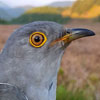The British Trust for Ornithology have been able to catch and fit transponders to several of this year's brood of Cuckoos, and will be following their progress as they fly south on their first migration to Central Africa. I am sponsoring one bird which was born in Wales, near Llangollen, which has been named Jac. The previous Welsh bird which I sponsored came from mid Wales and tracked directly over Martinstown several times on its migrations, but Jac has now been located in France and missed us by miles. The latest report from BTO:-

Llangollen Cuckoo JAC flew 340 km (211 miles) south-east across the English Channel, arriving in Normandy yesterday morning. He is close to Saint-Nicolas-de-la-Taille.
Jac now faces the long journey down through Spain, across the Med with perhaps a stop off to refuel in Morocco, and then the perilous crossing of the Sahara. But how on earth does he know the way?
